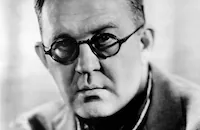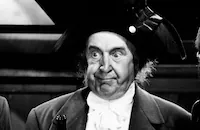The World Moves On
Brief Synopsis
Cast & Crew
John Ford
Madeleine Carroll
Franchot Tone
Reginald Denny
Siegfried Rumann
Louise Dresser
Film Details
Technical Specs

Synopsis
In 1825, New Orleans cotton magnate Sebastian Girard dies, and his will stipulates that his widow Agnes and their three sons, Richard, Carlos and John, must merge the family business with the company belonging to Englishman Gabriel Warburton. The new firm, which is intended to heal breaches caused by the War of 1812, will have offices in the United States, England, France and Prussia, the latter two of which will be run by Carlos and John. When the families gather to cement their relationship, Richard falls in love with Gabriel's wife Mary. Agreeing that the security of the family comes first, the would-be lovers deny their feelings and part. By 1914, four generations of the family have worked hard and the business is an enormous success. The families again assemble in New Orleans, where the attendees include English Sir John Warburton and his daughter Mary, the German Baron and Baroness von Gerhardt and their sons Erik and Fritz, and French Madame Girard and her children Henri, Jeanne and Jacques. Their American hosts are Charles Girard and his son Richard, who falls in love with Mary even though she is engaged to Erik. Mary reciprocates his feelings and is confused by his coldness later at the marriage of Fritz and Jeanne in Germany. Richard is distraught by the talk of Mary and Erik's upcoming wedding, and in his anguish he goes with Henri to Paris, where Henri joins the army and Richard joins the French Foreign Legion when the war starts. Soon after, Charles and John are on an ocean liner that is sunk by a German submarine captained by Fritz, which is in turn torpedoed by an Allied destroyer. Mary, who was released from her engagement to Erik when he realized that she loved Richard, is glad to see Richard when he comes to visit, but refuses his request to have the factories produce munitions. After a horrifying experience in the trenches, Richard returns to Mary and the couple are married. Richard goes back to the front, where he is wounded and taken prisoner. He is allowed to live with the von Gerhardts and witnesses the hardships inflicted by the war on the common German people. When the war finally ends, Richard goes home to Mary, and they settle in New York. By 1925, a lust for money and power has consumed Richard, and Mary is distraught over the changes in him. The horrors of war have made Henri seek peace in the priesthood, while his brother Jacques has grown up to be a cynic. Richard's world collapses with the stockmarket in 1929, and the family business is extinguished except for the English branch, which was saved by Mary's quick action. The family meets one last time, and when Jacques and Erik state that the world needs another war, the pregnant Mary rebukes them. As she condemns their militarism, she thinks of Hitler, Mussolini and various armies preparing for war. Mary and Richard then move to the old house in New Orleans, which has been tended by Richard's former war companion, Dixie. As the couple plan the nursery, they admire the crucifix in the family room and pray for peace.

Director

John Ford
Cast

Madeleine Carroll

Franchot Tone

Reginald Denny

Siegfried Rumann
Louise Dresser
Raul Roulien
Lumsden Hare

Dudley Digges
Frank Melton
Brenda Fowler
Russell Simpson
Walter Mcgrail
Marcelle Corday
Charles Bastin
Barry Norton

George Irving
Ferdinand Schumann-heink
Georgette Rhodes
Claude King

Ivan Simpson
Frank Moran

Stepin Fetchit
William Worthington
Emmett King
Sydney De Grey
Otto Kottke
Mario Dominici
Billy Mcclain
Jack Pennick
Pierre Callos
Hans Joby
Torben Meyer
Anders Van Haden
Margaret Mann
Winter Hall
Neville Clark
Eva Dennison
Ben Hall
Alphonse Martell
Ramsay Hill
Anita Brown
Jacques Lory
Francis Ford
George Renault
Harry Tenbrook
Andre Cheron
George Milo
Fred Cavens
Beulah Hall Jones
Louise La Croix
Perry Vekroff
Pierre Couderc
Crew
Doris Anderson
Reginald Berkeley
William Conselman
Joseph Cunningham
William Darling
James Gleason
E. F. Grossman
Llewellyn Hughes
Rita Kaufman
Arthur Lange
Paul Lockwood
Edward T. Lowe Jr.
B. F. Mceveety
Ed O'fearna
George Schneiderman
Winfield Sheehan
Anthony Ugrin
John Van Wormer
Henry Wales
Paul Weatherwax

Film Details
Technical Specs

Articles
The World Moves On
The movie's episodic story of a 19th-century New Orleans plantation family and its rise to international power over the course of 100 years is so derivative of the recent Best Picture winner Cavalcade (1933) that Fox, the same studio behind Cavalcade, even assigned the same screenwriter, Reginald Berkeley, to the new picture. Several actors -- including leading lady Madeleine Carroll, appearing here in an American film a full year before The 39 Steps (1935) allegedly brought her to Hollywood's attention -- play dual roles, appearing in the later sections as descendants of their original characters. (Ford biographer Andrew Sinclair later wrote that "Madeleine Carroll was after Ford as much as the leading role.") The film's most powerful sequences, depicting World War I, weren't even shot by Ford. Instead they are comprised of footage lifted from the 1932 French picture Wooden Crosses. Nonetheless, these scenes drew most of the critical praise. Variety, for one, exclaimed, "Holds six minutes of some of the most graphic war stuff ever publicly screened in this country... Certainly no staged matter on the big strife has so realistically photographed shrapnel bursts over the men as they fling themselves from shell hole to shell hole, or the house to house fighting through a village."
The review continued: "John Ford has had his hands full and hasn't entirely succeeded. The picture's takeoff is inactive, the war sequence is like a cold shower and then the film seems to wind its way back to its original groove. The fault appears to lay at Ford's door either because of his disregard of tempo or a disinclination to cut." The New York Times echoed this assessment, concluding simply: "It does seem as though the film would be all the better if it were shortened."
The reason The World Moves On feels too long or out of proper "tempo" can probably be found in a story Ford used to tell interviewers in his later years. While he never actually named the movie in question, Ford told of once having been ordered by a producer to shoot a script without changing a single word. Ford said he hated that particular script and didn't appreciate being told how to direct, so he complied with the instructions literally, filming every word of dialogue and stage direction despite knowing the picture would be overlong, and leaving the footage for the producer to edit. Historians generally agree that this must have been The World Moves On.
Esteemed film scholar William Everson made a case for the film, which he described as "a mating of Showboat (1936) with The House of Rothschild (1934)." Everson noted the influence of D.W. Griffith both in its overall epic approach and in some individual scenes, like a major off-screen reunion that echoes a similar scene in Birth of a Nation (1915). "Although disappointing as a Ford," Everson wrote, "it's a handsome and interesting film, quite undeserving of its shunted-aside, 'best-forgotten' reputation." Everson also observed "it has far more technique for its own sake than was usual with Ford," such as a constantly moving camera, evidence that Ford was sticking very closely to the script "instead of following his own (and normally simpler) inclinations."
The antiwar tone of the film is also not particularly indicative of Ford, and is rather more in keeping with the social consciousness that was coming out of the Fox studio at the time.
On July 11, 1934, The World Moves On became the first film to receive the Production Code seal of approval, marking the end of what is now known as the "pre-Code" era of Hollywood filmmaking.
In 1936, Howard Hawks would borrow the same Wooden Crosses battle footage for his WWI film The Road to Glory.
Producer: Winfield Sheehan
Director: John Ford
Screenplay: Reginald Berkeley (story and screenplay); William M. Conselman, Joe Cunningham, James Gleason, Llewellyn Hughes, Edward T. Lowe, Jr., Henry Wales, Doris Anderson (all uncredited)
Cinematography: George Schneiderman
Film Editing: Paul Weatherwax (uncredited)
Cast: Madeleine Carroll (Mrs. Warburton, 1825/Mary Warburton Girard, 1914), Franchot Tone (Richard Girard), Reginald Denny (Erik von Gerhardt), Siegfried Rumann (Baron von Gerhardt), Louise Dresser (Baroness von Gerhardt), Raul Roulien (Carlos Girard, 1825/Henri Girard, 1914), Stepin Fetchit (Dixie), Lumsden Hare (Gabriel Warburton, 1825/Sir John Warburton, 1914), Dudley Digges (Mr. Manning), Frank Melton (John Girard, 1825).
BW-104m.
by Jeremy Arnold
SOURCES:
Peter Bogdanovich, John Ford
William K. Everson, New School program notes (1972 and 1989)
Andrew Sarris, The John Ford Movie Mystery
Andrew Sinclair, John Ford

The World Moves On
Quotes
Trivia
This was the first film to be granted the production seal-of-approval under new guidelines set forth by the Production Code Administration Office.
Notes
Actor Franchot Tone was borrowed from M-G-M for this production, which was English actress Madeleine Carroll's first Hollywood film. Although Hollywood Reporter production charts include Nigel Bruce, Drue Leyton, Halliwell Hobbes and José Mojica in the cast, their participation in the completed film has not been confirmed. According to a final shooting script, dated February 21, 1934, which is contained in the Twentieth Century-Fox Produced Scripts Collection at the UCLA Theater Arts Library, Harry Wood was set to appear in the film, but his participation in the finished picture has also not been confirmed. The collection contains a memo, written to screenwriter Reginald Berkeley by producer Winfield Sheehan, stating that "The will [of "Sebastian Girard"], which will be read out, should aim at securing and perpetuating the family fortune, based on the working of the Rothschild will." Information in the Twentieth Century-Fox Records of the Legal Department, also located at UCLA, confirms that the Rothschild family was an inspiration for the family structure in the film. In Sheehan's memo, the producer recommended that Berkeley and director John Ford look at a book of World War I photographs taken by Laurence Stallings, who was also a screenwriter. Apparently the book presented a history of the war and "the cynical idea that the whole world is preparing for war again." The story files also contain clippings about the 1933 death of Henry Cushing Collins, who apparently was the first American to enlist in the French Foreign Legion during World War I. Although there is no explanation in the files about the clippings, it May be that Collins inspired the decision to have the character Richard Girard join the Legion. Ads in Motion Picture Herald indicate that the picture opened at the Radio City Music hall in New York on August 2, 1934 at "popular prices." It had played previously at the Criterion Theatre in New York, where it opened on June 28, 1934, on a twice-a-day basis with higher ticket prices. Although the Daily Variety review erroneously lists the picture's running time as 150 minutes, the Variety review and other sources list it as around 104 minutes. The World Moves On was the first film to receive a numbered certificate of approval from the Production Code Administration, which was formed in July 1934.
According to information in the legal records, this film used approximately 651 feet of battle scenes and scenes of parading soldiers taken from the 1932 Pathé-Natan French film Les croix de bois. The French film, which was directed by Raymond Bernard and based on the book of the same name by Roland Dorgelès, had been purchased by Fox, but was not distributed by them in the United States. According to a 1937 legal document, this picture was "written expressly" for the purpose of using the footage. For more information about Les croix de bois, please see the entry above for The Road to Glory, which also used footage from the French film. The legal records for The Road to Glory indicate that in late 1933, contributing writers Llewellyn Hughes, Doris Anderson and Henry Wales wrote scenarios for The World Moves On based on Les croix de bois. Their scenario titles, which May have been the film's working titles, were, respectively: Wooden Crosses, Fifty Miles from Paris and Blood and Glory.
The legal records also contain information about a lawsuit filed against Fox by Quirico Michelana y Llaguno, a Mexican citizen, who claimed that the studio had plagiarized a motion picture scenario he had written entitled Peace in War. The World Moves On was released in Mexico as Peace on Earth, and Llaguno maintained that it was plagiarized from his scenario, which he alleged he had submitted to Fox. Although Fox maintained that Llaguno did not register his scenario with the Screen Writers Guild in Hollywood until after shooting on the picture had commenced, the studio lost the case and their appeal, after which they settled the case with Llaguno for $7,800. Another case was filed against Fox by Edmund Benguiat, but the disposition of that case has not been determined.














